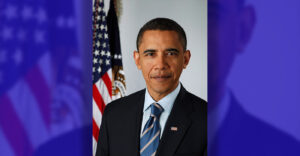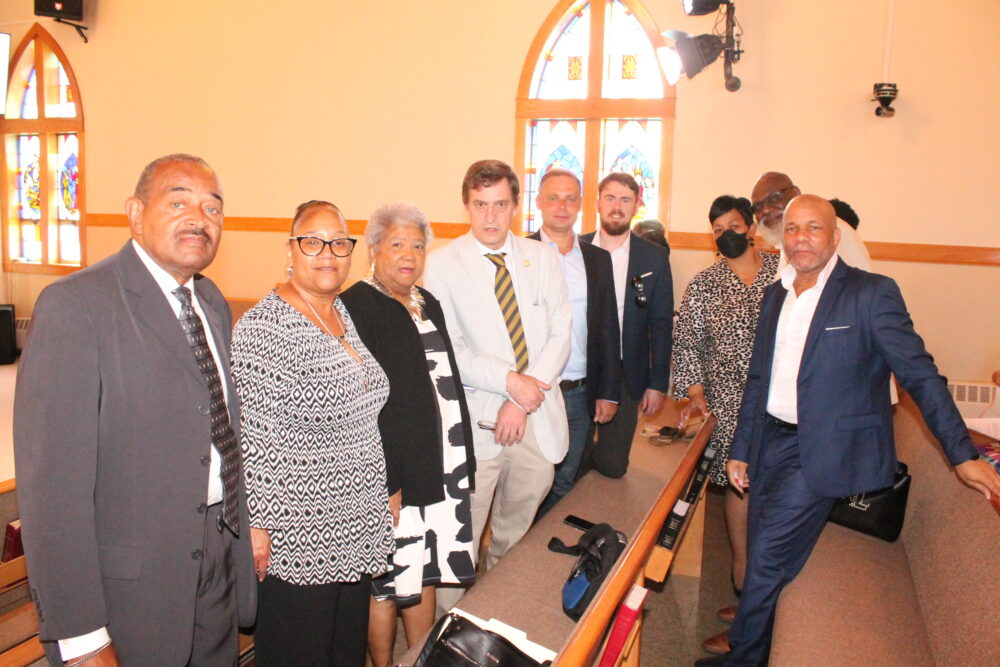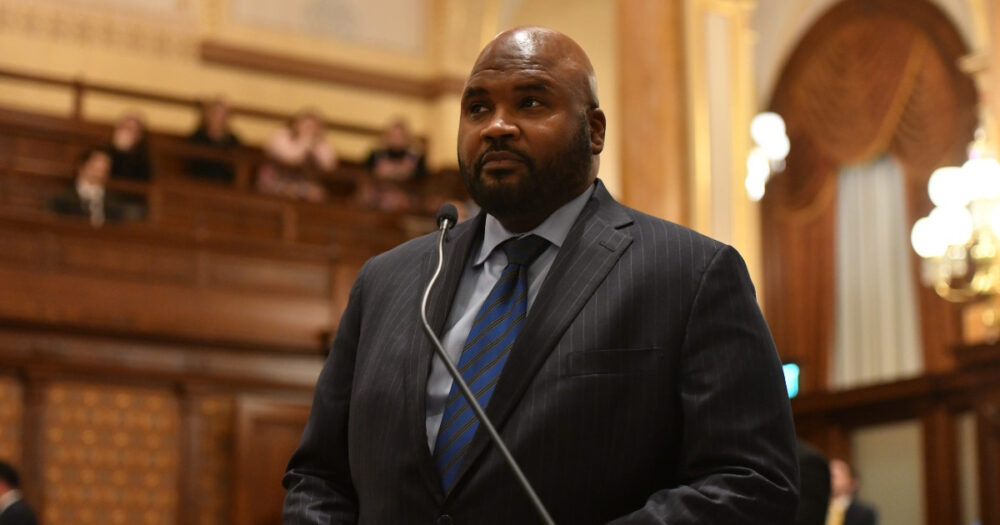Hours after Whole Foods announced it was leaving Englewood late last month, community members gathered at the Go Green Community Fresh Market on 63rd Street for an event with the rapper Freeway.
The event at Fresh Market, which the nonprofit Inner-City Muslim Action Network opened in March, had been scheduled before the Whole Foods announcement was made public. But the evening turned into “an oasis and a hub for healing,” said Sana Syed, IMAN’s director of strategic initiatives.
Advertisement
“There was a lot of hope, there was a lot of healing and there was a lot of drive,” Syed said of that night. “We are a resilient community, and honestly, if Whole Foods is going to leave, it is their loss.”
[ Para leer en español, haga clic aquí ]
Whole Foods opened its store at 63rd and Halsted Street to much fanfare in 2016, under the administration of former Mayor Rahm Emanuel. Chicago Neighborhood Initiatives received $10.7 million in city funding to prepare the site before the city sold it to developer Leon Walker of DL3 Realty for $1.
Advertisement
The sale agreement requires a full-service grocery store to operate in the Englewood Square development, where Whole Foods is currently the anchor tenant, until November 2027, said Peter Strazzabosco, spokesperson for the city’s Department of Planning and Development. When Whole Foods leaves, the agreement requires a new grocery store to be up and running within 18 months.
The plan to bring a premium-priced grocer to one of Chicago’s most disinvested neighborhoods was a bold one. But despite any initial hesitations, community leaders remember the early days of the partnership as fruitful.
The company initially priced about 30 items, like milk, bread, eggs and some produce, much cheaper than in other Chicago-area stores. About 40 local vendors sold their goods on Whole Foods’ shelves. The company hired a community engagement specialist, Cecile DeMello, to help build ties with the Englewood community. Residents gathered at the store for cooking demonstrations, yoga classes and cocktail hours. When state Rep. Sonya Harper’s district offices were under construction, she took meetings at Whole Foods.
“We always called it the miracle on 63rd,” said Walker, managing partner at DL3 Realty.
Englewood community leaders said that though the closure announcement saddened them, they weren’t wholly surprised by the news. Some said rumors about the store closing had circulated for some time. After Amazon bought Whole Foods in 2017, some of the optimism that marked the store’s early days dissipated. Community events at the store became less frequent, some said.
Advertisement
Whole Foods announced the closure of the Englewood store in late April, the same time it announced the closure of another Chicago location in the DePaul University Welcome Center and four other stores around the country. The company said in April that the Englewood store would close “in the coming months.” A company spokesperson has since declined to provide a more specific date.
The same week the company announced the Englewood closure, it opened an almost 66,000-square-foot Whole Foods location in the Near North neighborhood.

Walker, the developer, said there had been “some work around the issue” of closure this year, but that discussions “seemed to get accelerated” when Amazon reported its first quarter numbers earlier this spring. Amazon posted a $3.8 billion loss in the first quarter of 2022.
Advertisement
In Englewood, other grocery options include a recently renovated Aldi two blocks east of Whole Foods on 63rd, which has been there since the early 1990s, a Food 4 Less in West Englewood and the Fresh Market, which IMAN opened in March as part of the Go Green on Racine project. Many Englewood residents rely at least in part on corner stores, which food leaders say often do not offer high-quality foods or dignified shopping experiences.
Community leaders in food access are working on grassroots efforts to connect residents with healthy, high-quality foods, particularly fresh produce. They say access to healthy food is critically important in Englewood, where a 2019 study found residents to have a life expectancy of 60 years — 30 years less than the life expectancy in predominantly white Streeterville, just 9 miles north.
A 2021 report from Chicago’s Department of Public Health found that in 2018, just over 60% of Black Chicagoans had easy access to fresh fruits and vegetables, compared with about 73% of non-Black Chicagoans.
Advertisement
In an interview, Walker said DL3 Realty had started discussions with grocers about operating at the Whole Foods site. “We’ve had a lot of interest,” he said. “Several” local grocers and a couple of national ones are in the mix, he said.
Walker declined to name the grocers under consideration. He said the future operator should be neither a “gourmet, premium” grocer like Whole Foods, nor a deep discounter.
“We’re looking for an operator in the middle,” he said. “One that provides value, but also great presentation, shopping experience and product selection.”
Advertisement
Whole Foods has said little about its decision to close the store, issuing a brief statement at the time of the announcement: “As we continue to position Whole Foods Market for long-term success, we regularly evaluate the performance and growth potential of each of our stores, and we have made the difficult decision to close six stores.”
At an unrelated news conference shortly after the announcement, Mayor Lori Lightfoot called the closure a “gut blow” and said the city was “going to work our tails off” to get a new grocery store in place.
She blamed Whole Foods’ prices for the closure, saying the store was often empty, even on Saturdays.
“There’s a reason for that,” Lightfoot said. “I don’t know about most of you, but most Chicagoans are hard-pressed to pay, for example, $15 a pound for a piece of steak. We’ve got to make sure that we’re making the investments that make sense for those neighborhoods.”

Former Whole Foods co-CEO Walter Robb took issue with the mayor’s comments in an interview with the Tribune last week.
“I think the mayor’s comments were over the line, quite frankly, around saying it never had a chance. I don’t think that’s true,” he said. “I disagree with that 100%.”
Advertisement
Robb, who worked to bring the store to Englewood in partnership with Mayor Emanuel, said he was “on a personal level, heartbroken” by the closure. Robb said he couldn’t speak to the specifics of the store’s financial performance. “In the end, a business has to be profitable to be sustainable, and that’s true for any business,” he said.
“It’s hard to stay in business when you’re losing money month over month,” Robb said.
Community leaders acknowledged that Whole Foods’ prices may have been inaccessible to some Englewood residents. But they urged Chicagoans not to see the neighborhood as a monolith. Some said that perception, more than actual pricing, was a barrier, noting the store’s discounted pricing on staple items.
“Some of the prices there beat the competitors’ in the community,” said DeMello, who worked for Whole Foods as a community engagement specialist before she left during the company’s Amazon transition to take a job as the executive director of Teamwork Englewood, a nonprofit. “But the perception of the store was hard for people to break through.”
Advertisement
Asiaha Butler, co-founder and director of the Resident Association of Greater Englewood, or R.A.G.E., said her first choice would be for the former Whole Foods site to welcome a Black grocer with a track record of being socially responsible, one that would hire for the store locally. A second choice would be a local grocery operator “maybe not as big as a Whole Foods,” she said.
“A lot of community members are seeing how a national retailer can up and leave,” said DeMello.
Community members agree that whatever happens at 63rd and Halsted is only one part of the story. All said that what Englewood needs are options.
“I lived on the North Side,” said Janelle St. John, the executive director of Growing Home, a USDA-certified organic urban farm in West Englewood. “There was a Jewel next to a Dominick’s next to an Aldi’s. People should be able to shop around.
“For me, one grocery store within blocks and blocks is not to say the complete solution, we need more options. And just like North Side residents have options, Englewood and the South Side residents should have options.”

Some grocery options should be walkable, St. John said. Others should be easy to drive to. Some should be located on busy streets, so they’re accessible to people who take the bus.
Advertisement
“We have to ask ourselves in Chicago why is it that communities like Englewood only have limited store options to begin with,” said Anton Seals Jr., executive director of Grow Greater Englewood, a food and land sovereignty nonprofit. “How did we get to, like, you’re a one-and-done kind of community?”
Harper, who had been involved in the Whole Foods opening when she was working at Grow Greater Englewood, pointed to Chicago’s history of white flight as part of the explanation. Communities like Englewood that don’t have enough food options also frequently lack other resources, like health care or recreational resources, she said.
“When we moved into these communities they were stocked with everything that we needed, but over time, businesses chose to leave to go somewhere else,” Harper said. “Somewhere else they thought was more profitable, somewhere else where they thought that they liked the customers better.”
Advertisement
Food leaders in Englewood are engaged in a wide range of grassroots efforts to connect neighborhood residents with high-quality, affordable fresh foods. The Go Green Community Fresh Market, modeled after what a corner store might look like if it offered a full range of grocery items and a dignified shopping experience, is one example.

The store grew out of IMAN’s campaign to work with corner store owners to offer healthier options themselves, Syed said. Across the street from the Fresh Market is IMAN’s food pantry. Growing Home donates and sells at discounted prices its organic produce throughout Englewood.
This summer Grow Greater Englewood will launch a pilot program to connect local restaurants with fresh produce from local Black and brown farmers, and in turn connect Englewood residents with meals made from that produce at free and reduced price.
But leaders say no one solution is enough, and that the neighborhood simply needs more grocery stores.
“Produce is not enough, and one Growing Home is not enough. And though there are other local farmers in Englewood, none of us are growing at a capacity to meet our community needs 100%,” St. John said. “Nor is one Whole Foods.”

A bill sponsored by Harper and passed by both houses in the state legislature would provide funding and other assistance to grocery stores, farmers markets and other small food retailers in areas that lack sufficient access to healthy foods. It is waiting for a signature from Gov. J.B. Pritzker. If it passes, a funding mechanism for the bill would be determined during appropriations, Harper said.
Advertisement
Syed urged Chicagoans to remember that Englewood residents have buying power. When they leave the neighborhood to purchase groceries, their dollars leave with them, she said.
“The same dollar that’s spent on the North Side is spent on the South Side,” St. John said. “It’s not like it’s a different currency.”
Chicago Tribune reporter Gregory Pratt contributed.







